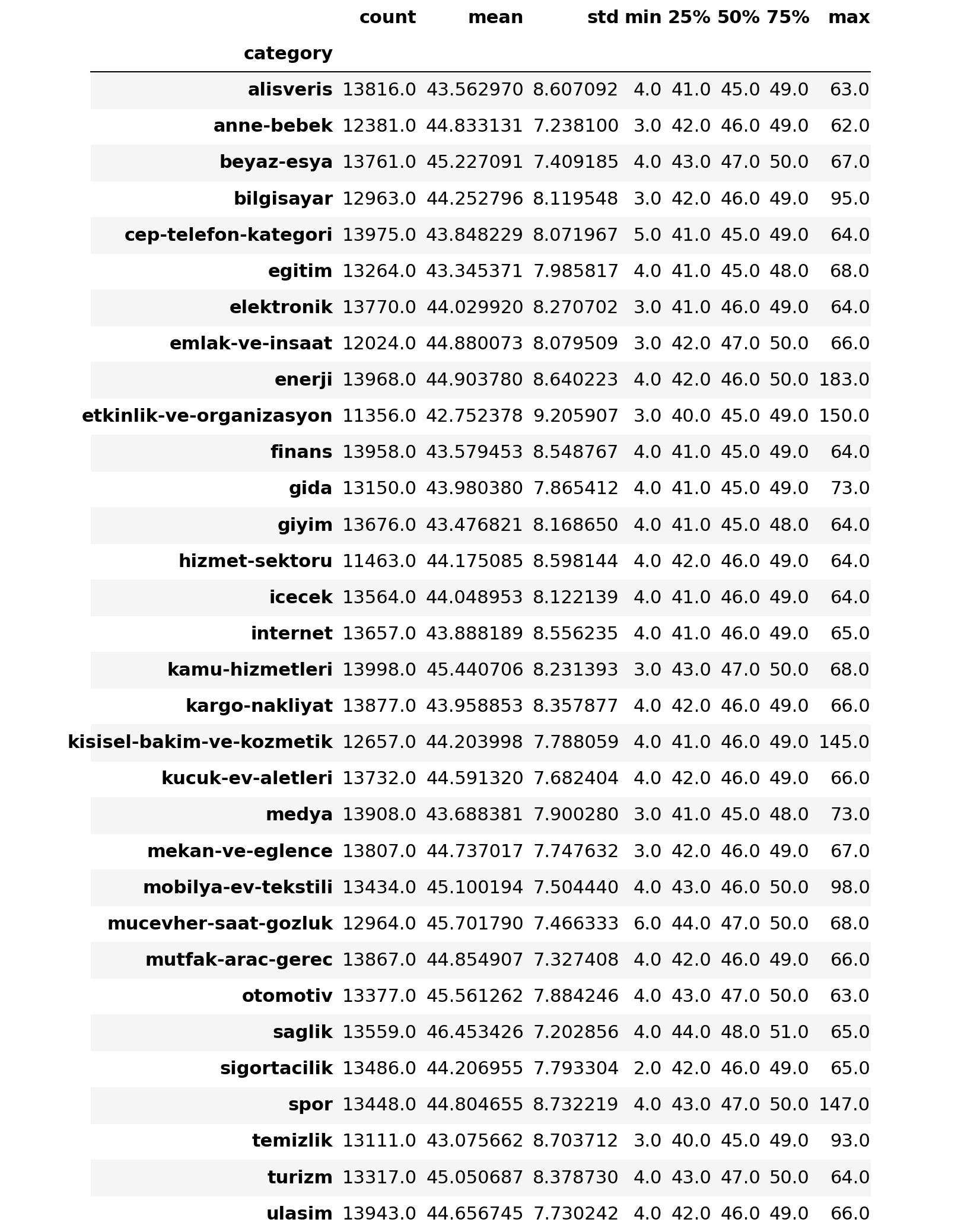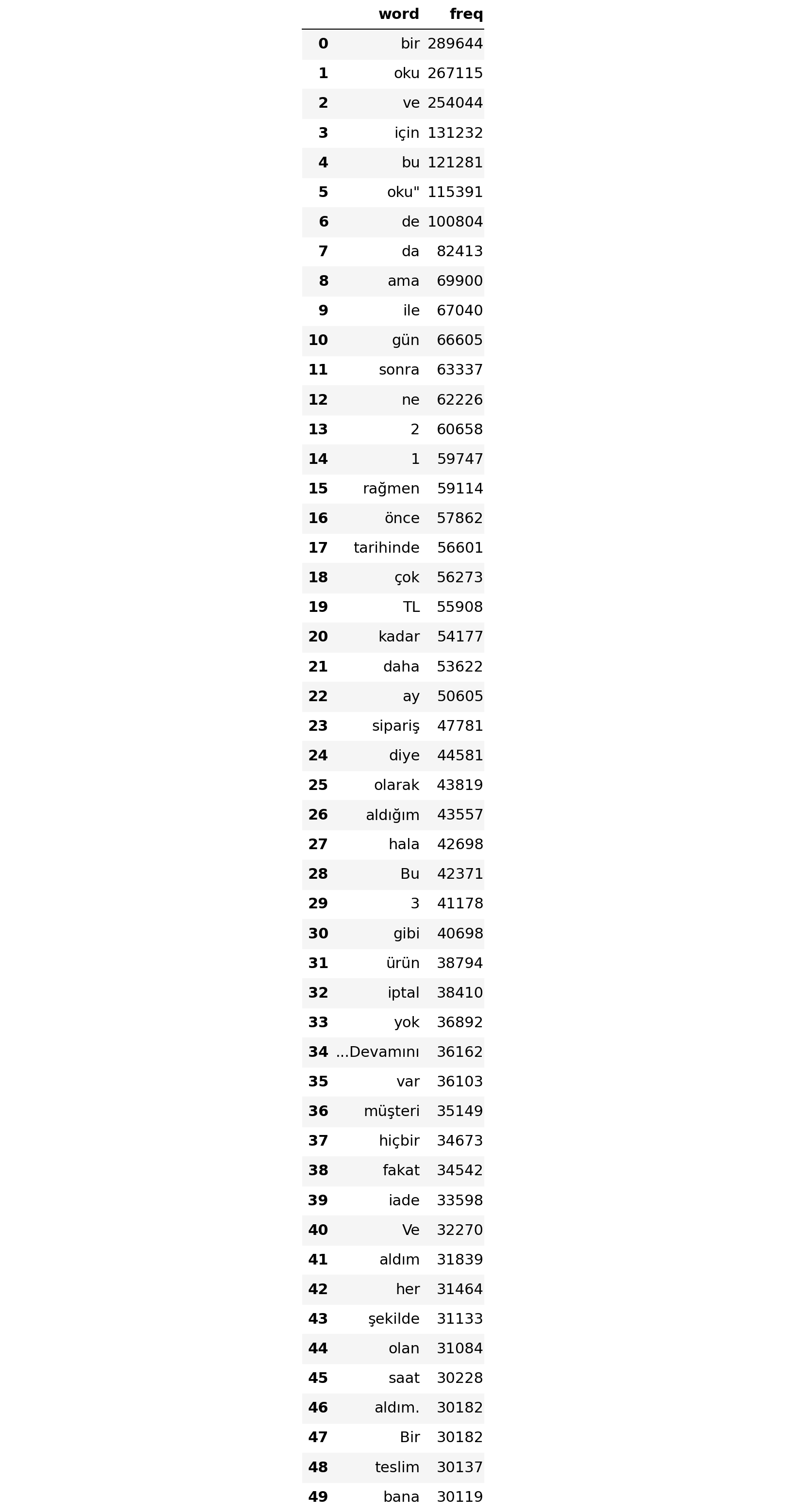Part B: Exploratory Data Analysis (EDA)
Multi-Topic Text Classification with Various Deep Learning Models
Author: Murat Karakaya
Date created….. 17 09 2021
Date published… 13 03 2022
Last modified…. 12 03 2022
Description: This is the Part B of the tutorial series “Multi-Topic Text Classification with Various Deep Learning Models” that covers all the phases of text classification:
- Exploratory Data Analysis (EDA),
- Text preprocessing
- TF Data Pipeline
- Keras TextVectorization preprocessing layer
- Multi-class (multi-topic) text classification
- Deep Learning model design & end-to-end model implementation
- Performance evaluation & metrics
- Generating classification report
- Hyper-parameter tuning
- etc.
We will design various Deep Learning models by using
- the Keras Embedding layer,
- Convolutional (Conv1D) layer,
- Recurrent (LSTM) layer,
- Transformer Encoder block, and
- pre-trained transformer (BERT).
We will cover all the topics related to solving Multi-Class Text Classification problems with sample implementations in Python / TensorFlow / Keras environment.
We will use a Kaggle Dataset in which there are 32 topics and more than 400K total reviews.
If you would like to learn more about Deep Learning with practical coding examples,
- Please subscribe to the Murat Karakaya Akademi YouTube Channel or
- Do not forget to turn on notifications so that you will be notified when new parts are uploaded.
- Follow my blog on muratkarakaya.net
You can access all the codes, videos, and posts of this tutorial series from the links below.
PART B: EXPLORATORY DATA ANALYSIS (EDA)
In this tutorial, I will use a Multi-Class Classification Dataset for Turkish. It is a benchmark dataset for the Turkish text classification task.
It contains 430K comments (reviews or complaints) for a total of 32 categories (products or services).
Each category roughly has 13K comments.
A baseline algorithm, Naive Bayes, gets an 84% F1 score.
However, you can download and use any other multi-class text datasets as well.
Load Stop Words in Turkish
As you might know “Stop words” are a set of commonly used words in a language. Examples of stop words in English are “a”, “the”, “is”, “are” and etc. Stop words are commonly used in Text Mining and Natural Language Processing (NLP) to eliminate words that are so commonly used that they carry very little useful information.
I begin with uploading an existing list of stop words in Turkish but this list is not an exhaustive one. We will add new words to this list after analyzing the dataset.
You can download this file from here.
tr_stop_words = pd.read_csv('tr_stop_word.txt',header=None)
print("First 5 entries:")
for each in tr_stop_words.values[:5]:
print(each[0])First 5 entries:
ama
amma
anca
ancak
bu
time: 212 ms (started: 2022-03-01 12:14:57 +00:00)
Load the Dataset
data = pd.read_csv('ticaret-yorum.csv')
pd.set_option('max_colwidth', 400)time: 6.11 s (started: 2022-03-01 12:14:58 +00:00)
Some Samples of Reviews (Text) & Their Corresponding Topics (Class)
data.head()
time: 47 ms (started: 2022-03-01 12:15:04 +00:00)Explore the Basic Properties of the Dataset
The shape of the dataset
print("Shape of data (rows, cols)=>",data.shape)Shape of data (rows, cols)=> (431306, 2)
time: 2.86 ms (started: 2022-03-01 12:15:04 +00:00)
Check the Null Values
Get the initial information about the dataset:
data.info()<class 'pandas.core.frame.DataFrame'>
RangeIndex: 431306 entries, 0 to 431305
Data columns (total 2 columns):
# Column Non-Null Count Dtype
--- ------ -------------- -----
0 category 431306 non-null object
1 text 431306 non-null object
dtypes: object(2)
memory usage: 6.6+ MB
time: 208 ms (started: 2022-03-01 12:15:04 +00:00)
According to data.info() there is no null values in the dataset but let's verify it:
data.isnull().sum()category 0
text 0
dtype: int64
time: 113 ms (started: 2022-03-01 12:15:04 +00:00)
Notice that according to the above numbers there are no null values in the dataset!
If there are any null values in the dataset, we could drop these null values as follows:
df.dropna(inplace=True)
df.isnull().sum()
Check the Duplicated Reviews
Let’s first find if there are any duplicated records
data.describe(include='all')
time: 1.25 s (started: 2022-03-01 12:15:04 +00:00)For category column there are 431306 rows and 32 unique values. However, for text column, there exists 431306 rows of which 427231 entries are unique. That is, for text column, there are some duplications: 431306 - 427231 = 4075
We can verify the duplications:
data.text.duplicated(keep="first").value_counts()False 427231
True 4075
Name: text, dtype: int64
time: 120 ms (started: 2022-03-01 12:15:05 +00:00)
Drop the duplicated reviews:
data.drop_duplicates(subset="text",keep="first",inplace=True,ignore_index=True)
data.describe()
time: 2.93 s (started: 2022-03-01 12:15:06 +00:00)Analyze the Classes (Topics)
Topic List
topic_list = data.category.unique()
print("Topics:\n", topic_list)Topics:
['alisveris' 'anne-bebek' 'beyaz-esya' 'bilgisayar' 'cep-telefon-kategori'
'egitim' 'elektronik' 'emlak-ve-insaat' 'enerji'
'etkinlik-ve-organizasyon' 'finans' 'gida' 'giyim' 'hizmet-sektoru'
'icecek' 'internet' 'kamu-hizmetleri' 'kargo-nakliyat'
'kisisel-bakim-ve-kozmetik' 'kucuk-ev-aletleri' 'medya'
'mekan-ve-eglence' 'mobilya-ev-tekstili' 'mucevher-saat-gozluk'
'mutfak-arac-gerec' 'otomotiv' 'saglik' 'sigortacilik' 'spor' 'temizlik'
'turizm' 'ulasim']
time: 52.4 ms (started: 2022-03-01 12:15:09 +00:00)
Number of Topics
number_of_topics = len(topic_list)
print("Number of Topics: ",number_of_topics)Number of Topics: 32
time: 4.66 ms (started: 2022-03-01 12:15:09 +00:00)
Number of Reviews per Topic
The number of reviews in each category:
data.category.value_counts()kamu-hizmetleri 13998
cep-telefon-kategori 13975
enerji 13968
finans 13958
ulasim 13943
medya 13908
kargo-nakliyat 13877
mutfak-arac-gerec 13867
alisveris 13816
mekan-ve-eglence 13807
elektronik 13770
beyaz-esya 13761
kucuk-ev-aletleri 13732
giyim 13676
internet 13657
icecek 13564
saglik 13559
sigortacilik 13486
spor 13448
mobilya-ev-tekstili 13434
otomotiv 13377
turizm 13317
egitim 13264
gida 13150
temizlik 13111
mucevher-saat-gozluk 12964
bilgisayar 12963
kisisel-bakim-ve-kozmetik 12657
anne-bebek 12381
emlak-ve-insaat 12024
hizmet-sektoru 11463
etkinlik-ve-organizasyon 11356
Name: category, dtype: int64
time: 57.4 ms (started: 2022-03-01 12:15:09 +00:00)
Let’s depict the number of reviews per topic as a bar chart:
data.category.value_counts().plot.bar(x="Topics",y="Number of Reviews",figsize=(32,6) )<matplotlib.axes._subplots.AxesSubplot at 0x7f40bce1d510>

time: 1.36 s (started: 2022-03-01 12:15:09 +00:00)As you see in the above numbers, we can argue that the dataset is a balanced one: the number of samples is evenly distributed over the topics.
Analyze Reviews (Text)
Some Review Samples
data.head(5)
time: 21.5 ms (started: 2022-03-01 12:15:10 +00:00)Calculate the number of words in each review
data['words'] = [len(x.split()) for x in data['text'].tolist()]time: 4.7 s (started: 2022-03-01 12:15:10 +00:00)data[['words','text']].head()

time: 52.6 ms (started: 2022-03-01 12:15:15 +00:00)Notice that most of the reviews end with “Devamını oku” (Read next). We will remove this repeated expression below!
Review Length in terms of Number of Words
data['words'].describe()count 427231.000000
mean 44.408624
std 8.108499
min 2.000000
25% 42.000000
50% 46.000000
75% 49.000000
max 183.000000
Name: words, dtype: float64
time: 32.8 ms (started: 2022-03-01 12:15:15 +00:00)
Note that:
- 75% of the reviews have less than 50 words.
- The longest review has 183 words.
We could (will) use these statistics
- to filter out some of the reviews,
- to determine the maximum review size
- etc.
Review Length in terms of Number of Words per Topic
data.groupby(['category'])['words'].describe()
time: 379 ms (started: 2022-03-01 12:15:15 +00:00)We observe that
- Only 9 out of 32 topics have longer reviews than 70 words.
- For all the topics, 75% of the reviews have less than 50 words.
That is, we can limit the reviews to 50 or 70 words.
Number of short reviews
We can check the number of short reviews by comparing a threshold:
min_review_size = 15
data[data['words']<min_review_size].count()category 4950
text 4950
words 4950
dtype: int64
time: 64.3 ms (started: 2022-03-01 12:15:15 +00:00)
Let’s see some short review samples:
data[data['words']<min_review_size]
time: 84.9 ms (started: 2022-03-01 12:15:15 +00:00)Decide minimum and maximum review size
Important: In some tasks, we can assume that short reviews can not convey necessary /enough information for training and testing an ML model. For example, in Text Generation, if you would like to generate longer text, you would prefer to train your model with longer text examples.
As a result, according to the ML task at hand, you can use the above statistics, to set up a minimum and maximum review size in terms of words.
Here, I set these parameters as follows:
min_review_size = 15
max_review_size = 40 #50time: 1.47 ms (started: 2022-03-01 12:15:16 +00:00)
Filter out the short reviews
In the initial raw data, after removing duplications, we have 427231 reviews.
data.count()category 427231
text 427231
words 427231
dtype: int64
time: 189 ms (started: 2022-03-01 12:15:16 +00:00)
Above, we observed that we have 4950 reviews whose length is less than min_review_size (15 words).
Let’s remove short reviews:
data= data[data['words']>=min_review_size]time: 49.9 ms (started: 2022-03-01 12:15:16 +00:00)
After filtering out these short reviews, we will end up with (427231–4950) 422281 as below:
data.count()category 422281
text 422281
words 422281
dtype: int64
time: 311 ms (started: 2022-03-01 12:15:16 +00:00)
Finally, verify that there is no review whose length is less than min_review_size
data[data['words']<min_review_size].count()category 0
text 0
words 0
dtype: int64
time: 31.9 ms (started: 2022-03-01 12:15:16 +00:00)
Trim the longer reviews
We will trim the longer reviews using Keras TextVectorization layer below.
Analyze the Vocabulary
Count the distinct words
Let’s look into the raw dataset to count the distinct words
vocab = set()
corpus= [x.split() for x in data['text'].tolist()]
for sentence in corpus:
for word in sentence:
vocab.add(word.lower())
print("Number of distinct words in raw data: ", len(vocab))Number of distinct words in raw data: 900327
time: 25.8 s (started: 2022-03-01 12:15:16 +00:00)
Note: This number is huge actually. If you investigate some vocabulary entries, you would see that there are several reasons for this big number:
list(vocab)[:25]['kırılmıştı)',
'yıkıyor,"alalı',
'bulamama,"w118949152',
'+1lt',
'1.30₺',
"oylat'taki",
'sistemse?',
'jeansten',
'i***r*...devamını',
'yokmuş,"11',
'hama',
'yollanmaması,"28',
'çıkarıcısıdır,',
'güncellemediniz.',
'duyarsızlığı,metroport',
'hırıltısı',
'mahvolurdu',
'resetle',
'ödeyerek!devamını',
'raporunda,2010',
'i̇ndirdi,can',
'kredi',
'etkinleştirdim',
'yaşayacağımız',
'azarlanacaklarını']
time: 156 ms (started: 2022-03-01 12:15:42 +00:00)
- There are some typos in the reviews so the same word is misspelled and counted as a new word several times such as “haksızlık” vs “hakszlık”.
- Some reviewers use the Turkish alphabet some use the English alphabet to write the same words such as “özgün” vs “ozgun”
- There are many stop words in Turkish :) We will apply several workarounds to remove such words in the text during preprocessing below.
NOTE that:
- we are just analyzing the data, we are not preprocessing it yet!
- we will use a much better method to split the text into tokens in preprocessing phase later.
- thus, here, we just aim to get familiar with the data at hand before starting to preprocess it.
Count the frequency of words in the raw dataset
word_freq= data.text.str.split(expand=True).stack().value_counts()
word_freq=word_freq.reset_index(name='freq').rename(columns={'index': 'word'})time: 30.4 s (started: 2022-03-01 12:15:42 +00:00)
Let’s check the top 50 words:
top_50_frequent_words = word_freq[:50]
top_50_frequent_words
time: 15.6 ms (started: 2022-03-01 12:16:13 +00:00)If you investigate the above top-50 frequent words carefully, you can notice that some words can be considered “stop words”, some others could be very informative for a classifier.
Let’s see which top-50 frequent words are in the stop-word list that we loaded at the beginning:
for each in top_50_frequent_words['word']:
if each in tr_stop_words.values:
print (each)bir
ve
için
bu
de
da
ama
ile
sonra
rağmen
önce
çok
kadar
daha
diye
gibi
yok
fakat
bana
time: 8.67 ms (started: 2022-03-01 12:16:13 +00:00)
Almost 20 words out of the top-50 words are stop words. Therefore, during preprocessing, we will take care of the stop-words.
Summary
In this part, we have explored the dataset and taken several actions and decisions:
- we removed the duplications and null values (if any)
- we observed that there are 32 topics and reviews are evenly distributed over these topics
- we decided the minimum and maximum review lengths
- we dropped the short reviews
In the next part, we will apply the text preprocessing by using the Keras TextVectorization layer.
Do you have any questions or comments? Please share them in the comment section.
Thank you for your attention!

